Engineered Superabsorbent Nanocomposite Reinforced with Cellulose Nanocrystals for Remediation of Basic Dyes: Isotherm, Kinetic, and Thermodynamic Studies
Abstract
:1. Introduction
2. Materials and Methods
2.1. Materials
2.2. Instrumentations
2.3. Preparation of Cellulose Nanocrystals (CNCs)
2.4. Preparation of Pectin-PAAc/CNC Nanocomposite
2.5. Swelling Properties
2.6. Adsorption Study
3. Results and Discussion
3.1. Characterization of the Prepared CNC
3.2. Fourier Transform Infrared Spectroscopy Analysis (FTIR)
3.3. X-ray Diffraction Analysis (XRD)
3.4. Swelling Behavior
3.5. Dye Adsorption
3.6. Adsorption Kinetics
3.7. Intraparticle Diffusion
3.8. Adsorption Isotherm Models
3.9. Thermodynamic Parameters of Adsorption
3.10. Atomic Force Microscopy (AFM)
4. Conclusions
Author Contributions
Funding
Institutional Review Board Statement
Informed Consent Statement
Data Availability Statement
Conflicts of Interest
References
- Thakur, S.; Chaudhary, J.; Kumar, V.; Thakur, V.K. Progress in pectin based hydrogels for water purification: Trends and challenges. J. Environ. Manag. 2019, 238, 210–223. [Google Scholar] [CrossRef] [PubMed] [Green Version]
- Zhou, C.; Wu, Q.; Lei, T.; Negulescu, I.I. Adsorption kinetic and equilibrium studies for methylene blue dye by partially hydrolyzed polyacrylamide/cellulose nanocrystal nanocomposite hydrogels. Chem. Eng. J. 2014, 251, 17–24. [Google Scholar] [CrossRef]
- Samadder, R.; Akter, N.; Roy, A.C.; Uddin, M.; Hossen, J.; Azam, S. Magnetic nanocomposite based on polyacrylic acid and carboxylated cellulose nanocrystal for the removal of cationic dye. RSC Adv. 2020, 10, 11945–11956. [Google Scholar] [CrossRef] [Green Version]
- Gul, K.; Sohni, S.; Waqar, M.; Ahmad, F.; Norulaini, N.N.; A.K., M.O. Functionalization of magnetic chitosan with graphene oxide for removal of cationic and anionic dyes from aqueous solution. Carbohydr. Polym. 2016, 152, 520–531. [Google Scholar] [CrossRef]
- Madiraju, S.V.H. Color Removal and Treatment of Dye and Sugar Waste Water Using Low Cost Adsorbents. Master’s Thesis, Cleveland State University, Cleveland, OH, USA, 2018. [Google Scholar]
- Saini, J.; Garg, V.K.; Gupta, R.K.; Kataria, N. Removal of Orange G and Rhodamine B dyes from aqueous system using hydrothermally synthesized zinc oxide loaded activated carbon (ZnO-AC). J. Environ. Chem. Eng. 2017, 5, 884–892. [Google Scholar] [CrossRef]
- Tara, N.; Siddiqui, S.I.; Rathi, G.; Chaudhry, S.A.; Inamuddin; Asiri, A.M. Nano-engineered Adsorbent for the Removal of Dyes from Water: A Review. Curr. Anal. Chem. 2020, 16, 14–40. [Google Scholar] [CrossRef]
- Julkapli, N.M.; Bagheri, S.; Hamid, S.B.A. Recent Advances in Heterogeneous Photocatalytic Decolorization of Synthetic Dyes. Sci. World J. 2014, 2014, 692307. [Google Scholar] [CrossRef] [Green Version]
- Piaskowski, K.; Świderska-Dąbrowska, R.; Zarzycki, P.K. Dye Removal from Water and Wastewater Using Various Physical, Chemical, and Biological Processes. J. AOAC Int. 2018, 101, 1371–1384. [Google Scholar] [CrossRef]
- Peng, N.; Hu, D.; Zeng, J.; Li, Y.; Liang, L.; Chang, C. Superabsorbent Cellulose–Clay Nanocomposite Hydrogels for Highly Efficient Removal of Dye in Water. ACS Sustain. Chem. Eng. 2016, 4, 7217–7224. [Google Scholar] [CrossRef]
- da Costa, J.S.; Bertizzolo, E.G.; Bianchini, D.; Fajardo, A.R. Adsorption of benzene and toluene from aqueous solution using a composite hydrogel of alginate-grafted with mesoporous silica. J. Hazard. Mater. 2021, 418, 126405. [Google Scholar] [CrossRef]
- El-Sherif, H.; El-Masry, M. Superabsorbent nanocomposite hydrogels based on intercalation of chitosan into activated bentonite. Polym. Bull. 2010, 66, 721–734. [Google Scholar] [CrossRef]
- Zhou, T.; Xiao, C.; Fan, J.; Chen, S.; Shen, J.; Wu, W.; Zhou, S. A nanogel of on-site tunable pH-response for efficient anticancer drug delivery. Acta Biomater. 2013, 9, 4546–4557. [Google Scholar] [CrossRef] [PubMed]
- El-saied, H.A.-a.; El-Fawal, E.M. Green superabsorbent nanocomposite hydrogels for high-efficiency adsorption and photo-degradation/reduction of toxic pollutants from waste water. Polym. Test. 2021, 97, 107134. [Google Scholar] [CrossRef]
- Martău, G.A.; Mihai, M.; Vodnar, D.C. The use of chitosan, alginate, and pectin in the biomedical and food sector—biocompatibility, bioadhesiveness, and biodegradability. Polymers 2019, 11, 1837. [Google Scholar] [CrossRef] [Green Version]
- Noreen, A.; Nazli, Z.-i.-H.; Akram, J.; Rasul, I.; Mansha, A.; Yaqoob, N.; Iqbal, R.; Tabasum, S.; Zuber, M.; Zia, K.M. Pectins functionalized biomaterials; a new viable approach for biomedical applications: A review. Int. J. Biol. Macromol. 2017, 101, 254–272. [Google Scholar] [CrossRef]
- Sutar, P.B.; Mishra, R.K.; Pal, K.; Banthia, A.K. Development of pH sensitive polyacrylamide grafted pectin hydrogel for controlled drug delivery system. J. Mater. Sci. Mater. Med. 2007, 19, 2247–2253. [Google Scholar] [CrossRef]
- Jung, J.; Arnold, R.; Wicker, L. Pectin and charge modified pectin hydrogel beads as a colon-targeted drug delivery carrier. Colloids Surf. B Biointerfaces 2013, 104, 116–121. [Google Scholar] [CrossRef]
- Mishra, R.K.; Datt, M.; Banthia, A.K. Synthesis and Characterization of Pectin/PVP Hydrogel Membranes for Drug Delivery System. AAPS PharmSciTech 2008, 9, 395–403. [Google Scholar] [CrossRef] [Green Version]
- Zhao, X.; Chen, Z.; Lin, N.; Ma, J. Water redispersion and cytotoxicity of reducing end-modified cellulose nanocrystals by grafting long-chain poly(ethylene oxide). Int. J. Biol. Macromol. 2021, 180, 143–151. [Google Scholar] [CrossRef]
- Ma, T.; Lv, L.; Ouyang, C.; Hu, X.; Liao, X.; Song, Y.; Hu, X. Rheological behavior and particle alignment of cellulose nanocrystal and its composite hydrogels during 3D printing. Carbohydr. Polym. 2020, 253, 117217. [Google Scholar] [CrossRef]
- de Lima, G.F.; de Souza, A.G.; Rosa, D.d.S. Nanocellulose as Reinforcement in Carboxymethylcellulose Superabsorbent Nanocomposite Hydrogels. In Macromolecular Symposia; Wiley Online Library: Weinheim, Germany, 2020; Volume 394, p. 2000126. [Google Scholar]
- Thomas, B.; Raj, M.C.; Athira, K.B.; Rubiah, M.H.; Joy, J.; Moores, A.; Drisko, G.L.; Sanchez, C. Nanocellulose, a Versatile Green Platform: From Biosources to Materials and Their Applications. Chem. Rev. 2018, 118, 11575–11625. [Google Scholar] [CrossRef] [PubMed]
- Raghav, N.; Sharma, M.R.; Kennedy, J.F. Nanocellulose: A mini-review on types and use in drug delivery systems. Carbohydr. Polym. Technol. Appl. 2020, 2, 100031. [Google Scholar] [CrossRef]
- Garg, V.; Kumar, R.; Gupta, R. Removal of malachite green dye from aqueous solution by adsorption using agro-industry waste: A case study of Prosopis cineraria. Dye. Pigment. 2003, 62, 1–10. [Google Scholar] [CrossRef]
- Ikram, M.; Abbas, S.; Haider, A.; Naz, S.; Ahmad, S.O.A.; Haider, J.; Ul-Hamid, A.; Shahzadi, A.; Shahzadi, I.; Butt, A.R. Efficient dye degradation, antimicrobial behavior and molecular docking analysis of gold (Au) and cellulose nanocrystals (CNC)-doped strontium oxide nanocomposites. J. Nanostruct. Chem. 2021, 1–18. [Google Scholar] [CrossRef]
- Dong, Y.-D.; Zhang, H.; Zhong, G.J.; Yao, G.; Lai, B. Cellulose/carbon composites and their applications in water treatment–A review. Chem. Eng. J. 2021, 405, 126980. [Google Scholar] [CrossRef]
- Chaichi, M.; Hashemi, M.; Badii, F.; Mohammadi, A. Preparation and characterization of a novel bionanocomposite edible film based on pectin and crystalline nanocellulose. Carbohydr. Polym. 2017, 157, 167–175. [Google Scholar] [CrossRef] [PubMed]
- Nasef, S.M.; Khozemy, E.E.; Mahmoud, G.A. Characterization and in vitro drug release properties of chitosan/acrylamide/gold nanocomposite prepared by gamma irradiation. Int. J. Polym. Mater. Polym. Biomater. 2018, 68, 723–732. [Google Scholar] [CrossRef]
- Mohamed, A.A.; Mahmoud, G.A.; ElDin, M.E.; Saad, E.A. Synthesis and properties of (Gum acacia/polyacryamide/SiO2) magnetic hydrogel nanocomposite prepared by gamma irradiation. Polym. Technol. Mater. 2019, 59, 357–370. [Google Scholar] [CrossRef]
- Lewandowska, A.E.; Eichhorn, S.J. Quantification of the degree of mixing of cellulose nanocrystals in thermoplastics using Raman spectroscopy. J. Raman Spectrosc. 2016, 47, 1337–1342. [Google Scholar] [CrossRef] [Green Version]
- Du, L.; Wang, J.; Zhang, Y.; Qi, C.; Wolcott, M.P.; Yu, Z. Preparation and Characterization of Cellulose Nanocrystals from the Bio-ethanol Residuals. Nanomaterials 2017, 7, 51. [Google Scholar] [CrossRef] [Green Version]
- Thakur, M.; Sharma, A.; Ahlawat, V.; Bhattacharya, M.; Goswami, S. Process optimization for the production of cellulose nanocrystals from rice straw derived α-cellulose. Mater. Sci. Energy Technol. 2020, 3, 328–334. [Google Scholar] [CrossRef]
- Gupta, V.; Ramakanth, D.; Verma, C.; Maji, P.K.; Gaikwad, K.K. Isolation and characterization of cellulose nanocrystals from amla (Phyllanthus emblica) pomace. Biomass-Convers. Biorefin. 2021, 1–12. [Google Scholar] [CrossRef]
- Naduparambath, S.; Jinitha, T.V.; Shaniba, V.; Sreejith, M.P.; Balan, A.K.; Balan, E. Isolation and characterisation of cellulose nanocrystals from sago seed shells. Carbohydr. Polym. 2018, 180, 13–20. [Google Scholar] [CrossRef] [PubMed]
- Manimaran, P.; Senthamaraikannan, P.; Sanjay, M.R.; Marichelvam, M.K.; Jawaid, M. Study on characterization of Furcraea foetida new natural fiber as composite reinforcement for lightweight applications. Carbohydr. Polym. 2018, 181, 650–658. [Google Scholar] [CrossRef] [PubMed]
- El-Sakhawy, M.; Kamel, S.; Salama, A.; Sarhan, H.A. Preparation and infrared study of cellulose based amphiphilic materials. Cellul. Chem. Technol. 2018, 52, 193–200. [Google Scholar]
- Monfregola, L.; Leone, M.; Vittoria, V.; Amodeo, P.; De Luca, S. Chemical modification of pectin: Environmental friendly process for new potential material development. Polym. Chem. 2011, 2, 800–804. [Google Scholar] [CrossRef]
- Khozamy, E.; Khozamy, E.; Mahmoud, G.A.; Saad, E.; Serror, S. Implementation of carboxymethyl cellulose/acrylic acid/titanium dioxide nanocomposite hydrogel in remediation of Cd (II), Zn (II) and Pb (II) for water treatment application. Egypt. J. Chem. 2019, 62, 1785–1798. [Google Scholar]
- Peng, C.; Dong, B.; Zhang, C.; Hu, Y.; Liu, L.; Zhang, X. A Host–Guest Interaction Assisted Approach for Fabrication of Polybutadiene Nanocomposites Reinforced with Well-Dispersed Cellulose Nanocrystals. Macromolecules 2018, 51, 4578–4587. [Google Scholar] [CrossRef]
- Deng, W.; Tang, Y.; Mao, J.; Zhou, Y.; Chen, T.; Zhu, X. Cellulose nanofibril as a crosslinker to reinforce the sodium alginate/chitosan hydrogels. Int. J. Biol. Macromol. 2021, 189, 890–899. [Google Scholar] [CrossRef]
- Li, H. Introduction. In Smart Hydrogel Modelling; Springer: Berlin/Heidelberg, Germany, 2009; pp. 1–55. [Google Scholar]
- Nair, S.S.; Zhu, J.Y.; Deng, Y.; Ragauskas, A.J. Hydrogels Prepared from Cross-Linked Nanofibrillated Cellulose. ACS Sustain. Chem. Eng. 2014, 2, 772–780. [Google Scholar] [CrossRef]
- Yin, O.S.; Ahmad, I.; Amin, M.C.I.M. Synthesis of chemical cross-linked gelatin hydrogel reinforced with cellulose nanocrystals (CNC). In Proceedings of the 2014 UKM FST Postgraduate Colloquium: Proceedings of the Universiti Kebangsaan Malaysia, Faculty of Science and Technology 2014 Postgraduate Colloquium, Selangor, Malaysia, 9–11 April 2014. [Google Scholar]
- Chen, L.; Zhu, Y.; Cui, Y.; Dai, R.; Shan, Z.; Chen, H. Fabrication of starch-based high-performance adsorptive hydrogels using a novel effective pretreatment and adsorption for cationic methylene blue dye: Behavior and mechanism. Chem. Eng. J. 2020, 405, 126953. [Google Scholar] [CrossRef]
- Vargas, A.M.M.; Cazetta, A.L.; Kunita, M.H.; Silva, T.L.; Almeida, V.C. Adsorption of methylene blue on activated carbon produced from flamboyant pods (Delonix regia): Study of adsorption isotherms and kinetic models. Chem. Eng. J. 2011, 168, 722–730. [Google Scholar] [CrossRef]
- Brouers, F.; Marquez-Montesino, F. Dubinin and the Brouers-Sotolongo Family Isotherms. arXiv 2016, arXiv:1602.05860. [Google Scholar]
- Al-Ghouti, M.A.; Da’Ana, D.A. Guidelines for the use and interpretation of adsorption isotherm models: A review. J. Hazard. Mater. 2020, 393, 122383. [Google Scholar] [CrossRef] [PubMed]
- Qu, J.; Liu, Y.; Cheng, L.; Jiang, Z.; Zhang, G.; Deng, F.; Wang, L.; Han, W.; Zhang, Y. Green synthesis of hydrophilic activated carbon supported sulfide nZVI for enhanced Pb (II) scavenging from water: Characterization, kinetics, isotherms and mechanisms. J. Hazard. Mater. 2021, 403, 123607. [Google Scholar] [CrossRef] [PubMed]
- Al Bsoul, A.; Hailat, M.; Abdelhay, A.; Tawalbeh, M.; Al-Othman, A.; Al-Kharabsheh, I.N.; Al-Taani, A.A. Efficient removal of phenol compounds from water environment using Ziziphus leaves adsorbent. Sci. Total Environ. 2020, 761, 143229. [Google Scholar] [CrossRef] [PubMed]
- Misra, D.N. Jovanovich adsorption isotherm for heterogeneous surfaces. J. Colloid Interface Sci. 1973, 43, 85–88. [Google Scholar] [CrossRef]
- Ayawei, N.; Ebelegi, A.N.; Wankasi, D. Modelling and Interpretation of Adsorption Isotherms. J. Chem. 2017, 2017, 3039817. [Google Scholar] [CrossRef]
- Jasper, E.E.; Ajibola, V.O.; Onwuka, J.C. Nonlinear regression analysis of the sorption of crystal violet and methylene blue from aqueous solutions onto an agro-waste derived activated carbon. Appl. Water Sci. 2020, 10, 1–11. [Google Scholar] [CrossRef]
- Karoui, S.; BEN Arfi, R.; Mougin, K.; Ghorbal, A.; Assadi, A.A.; Amrane, A. Synthesis of novel biocomposite powder for simultaneous removal of hazardous ciprofloxacin and methylene blue: Central composite design, kinetic and isotherm studies using Brouers-Sotolongo family models. J. Hazard. Mater. 2020, 387, 121675. [Google Scholar] [CrossRef]
- Guerrero-Fajardo, C.A.; Giraldo, L.; Moreno-Piraján, J.C. Preparation and characterization of graphene oxide for Pb (II) and Zn (II) ions adsorption from aqueous solution: Experimental, thermodynamic and kinetic study. Nanomaterials 2020, 10, 1022. [Google Scholar] [CrossRef] [PubMed]
- Pholosi, A.; Naidoo, E.B.; Ofomaja, A.E. Intraparticle diffusion of Cr(VI) through biomass and magnetite coated biomass: A comparative kinetic and diffusion study. S. Afr. J. Chem. Eng. 2020, 32, 39–55. [Google Scholar] [CrossRef]
- Babakhani, A.; Sartaj, M. Removal of Cadmium (II) from aqueous solution using tripolyphosphate cross-linked chitosan. J. Environ. Chem. Eng. 2020, 8, 103842. [Google Scholar] [CrossRef]
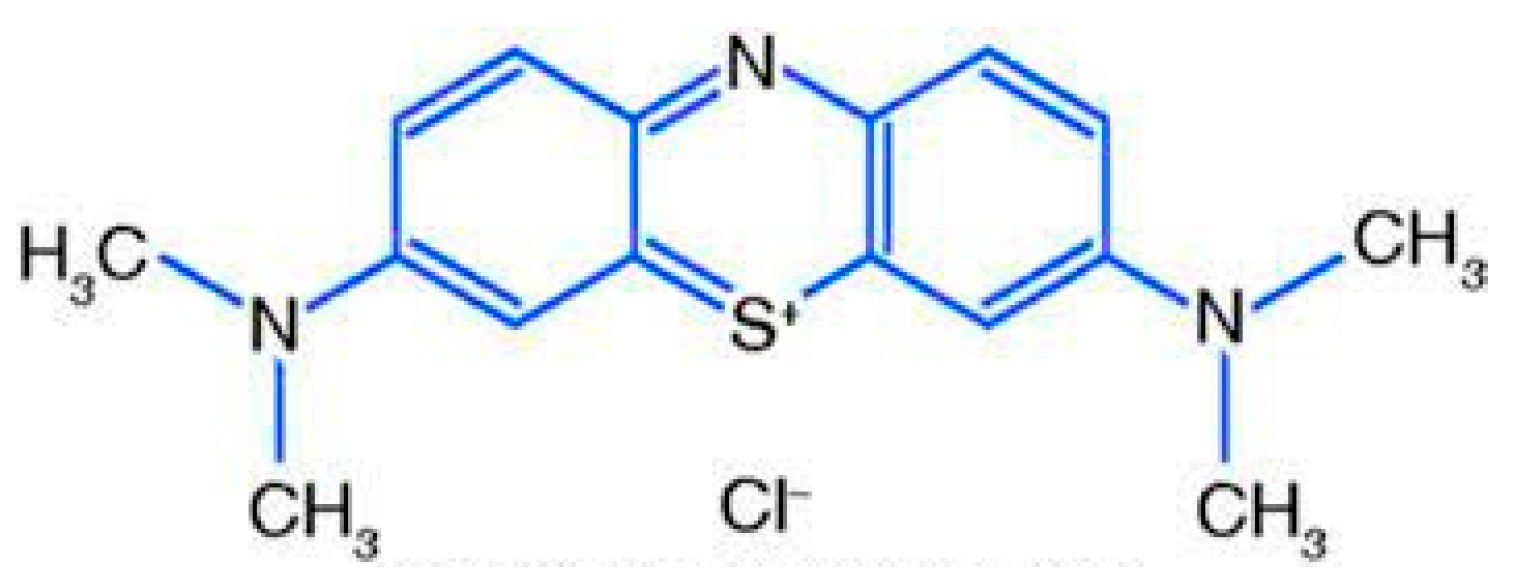
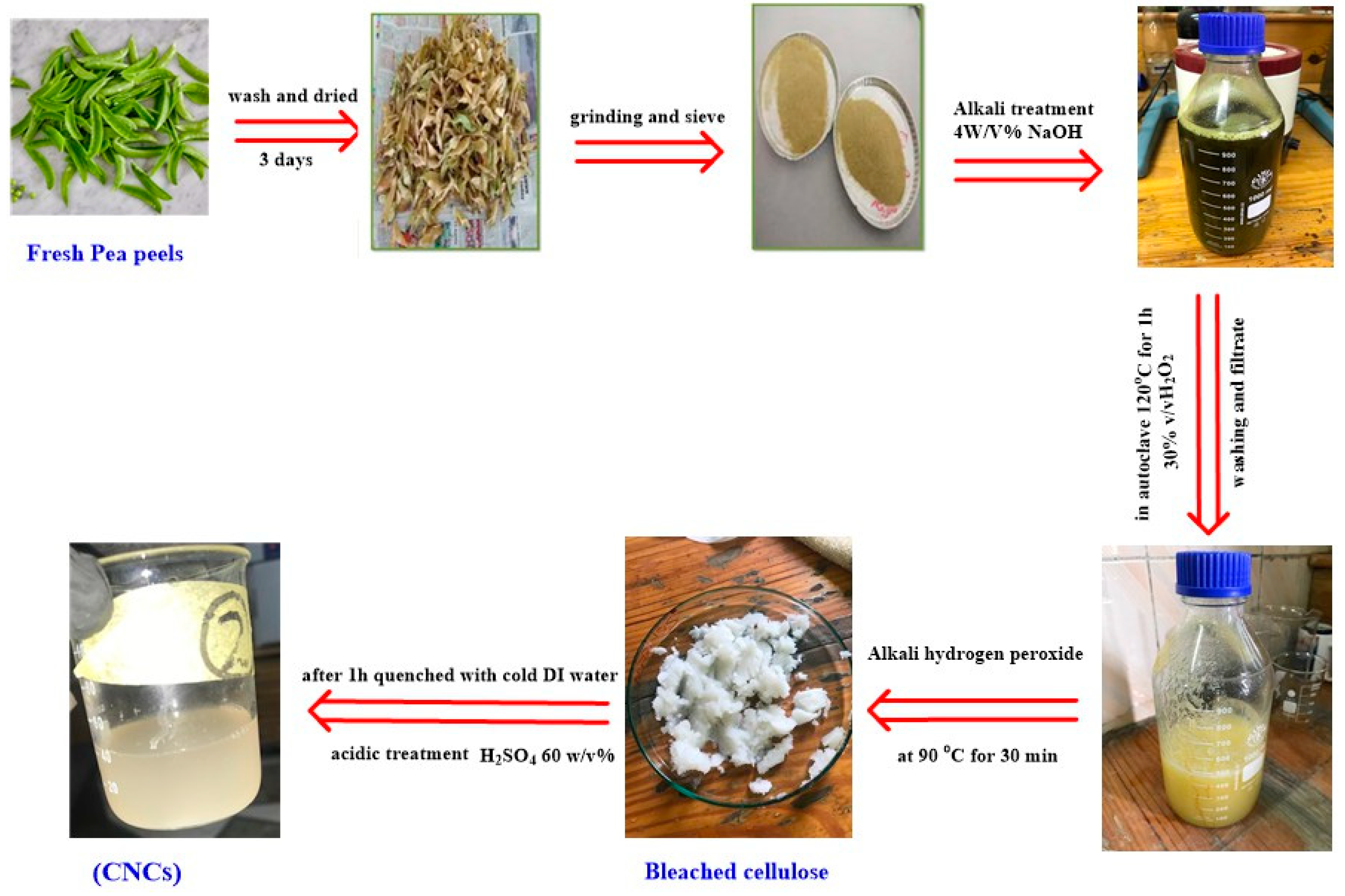

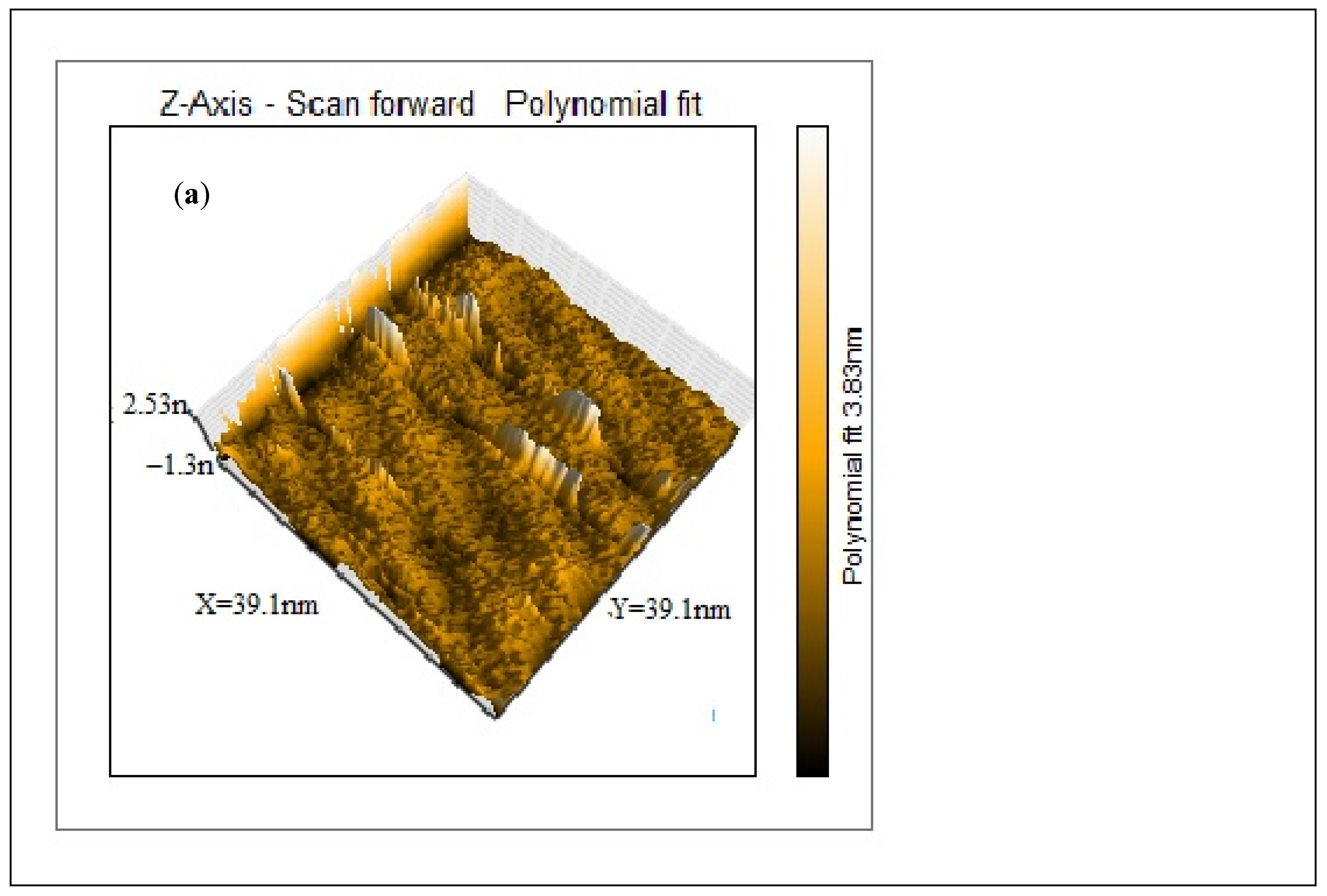

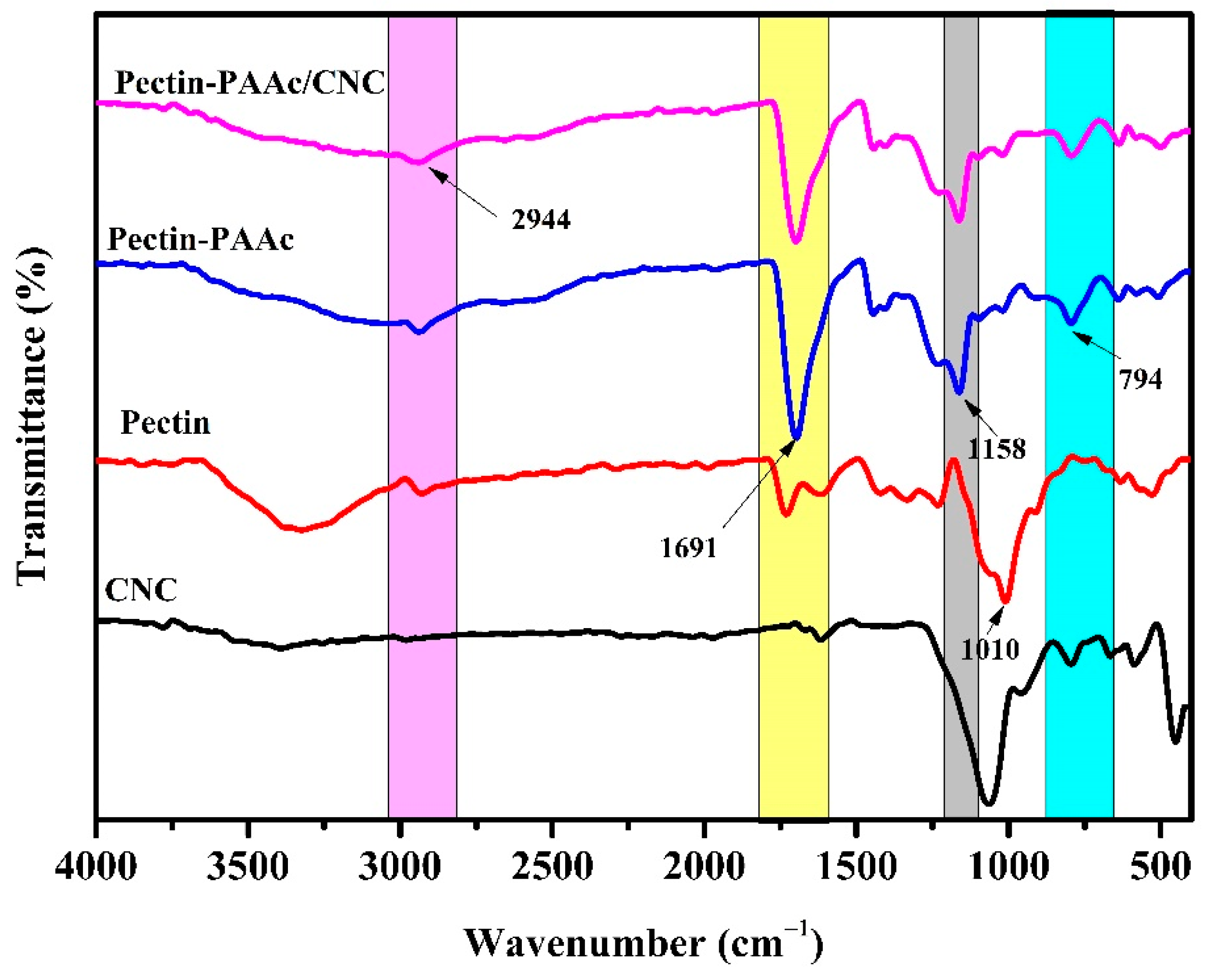



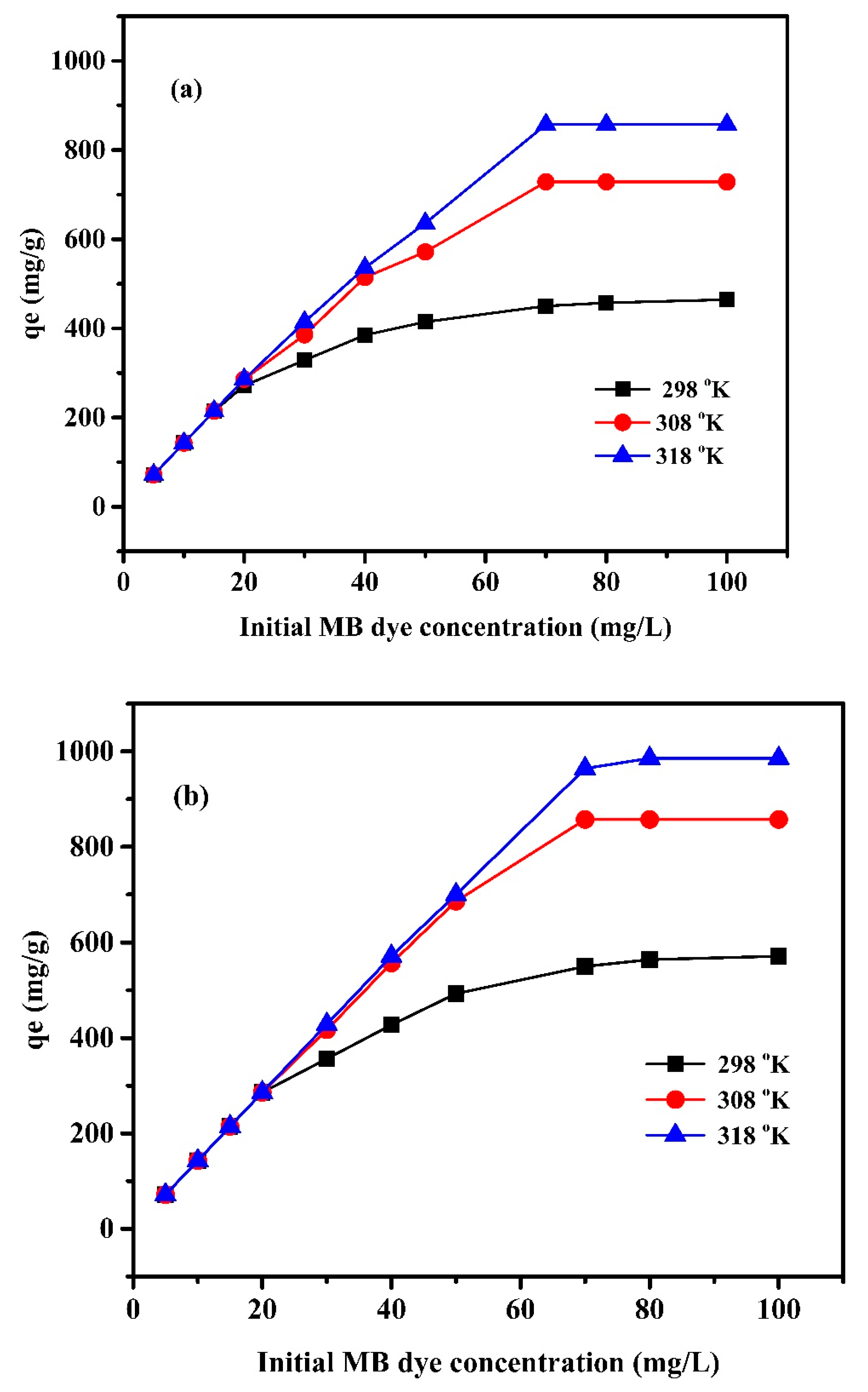

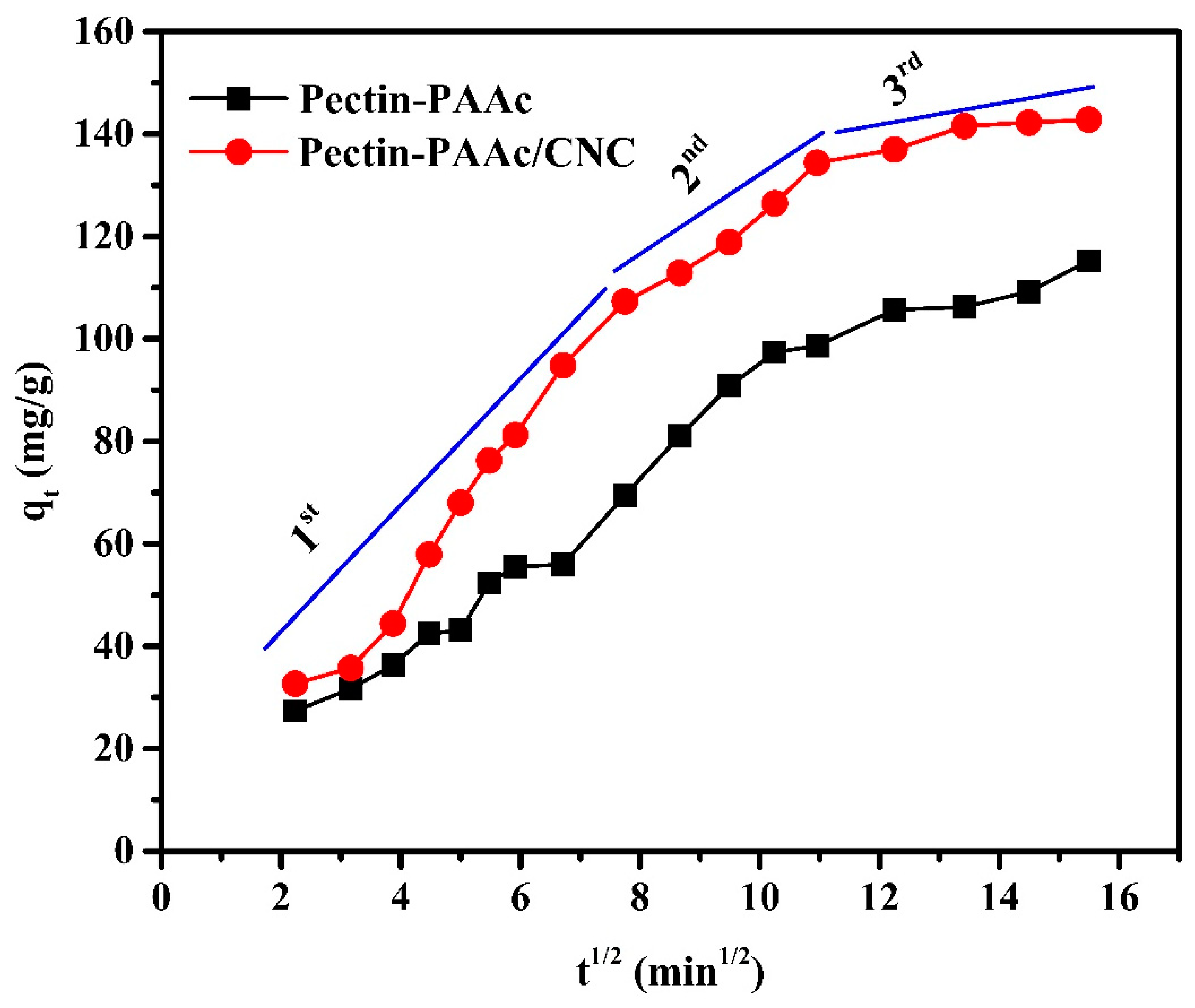
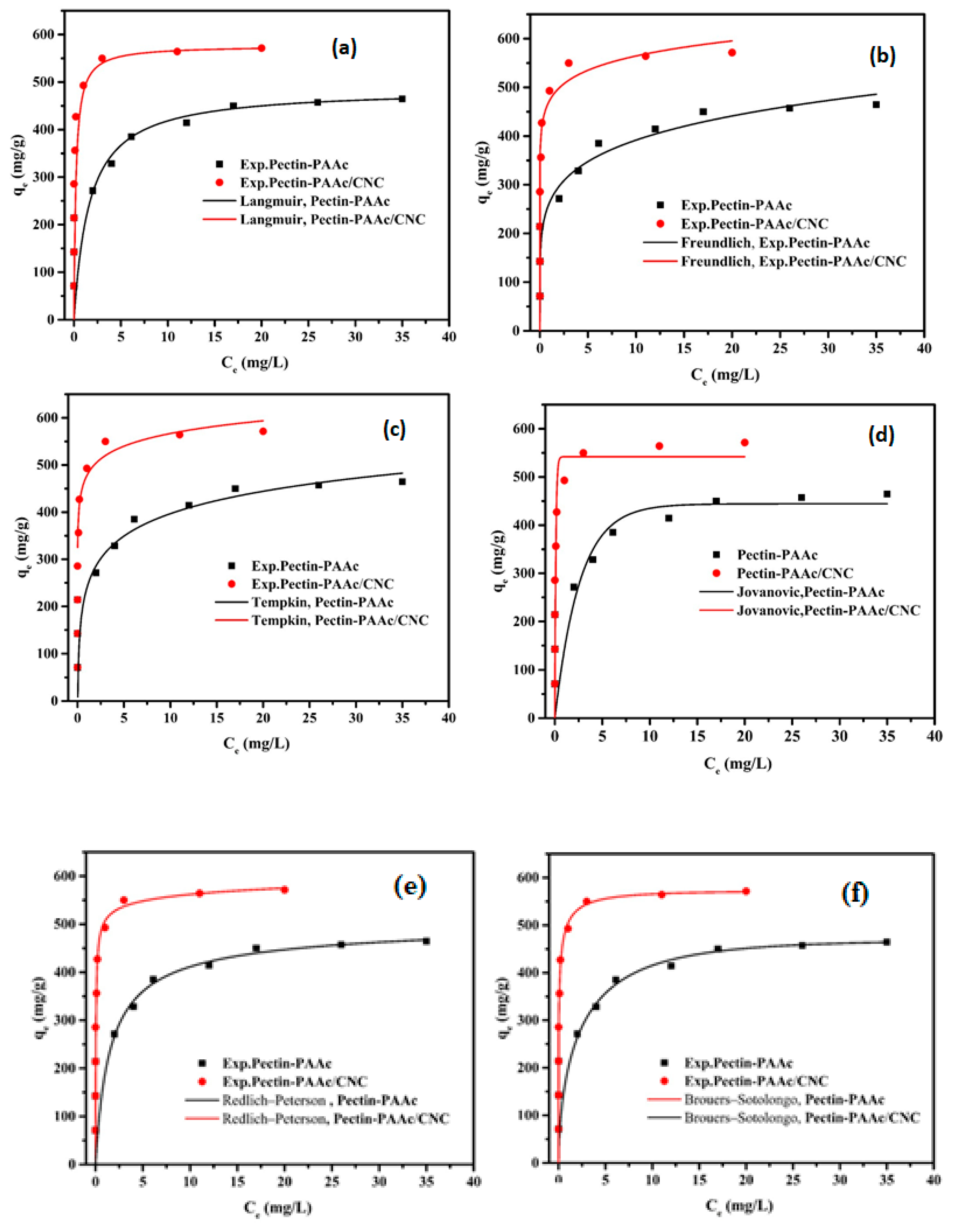
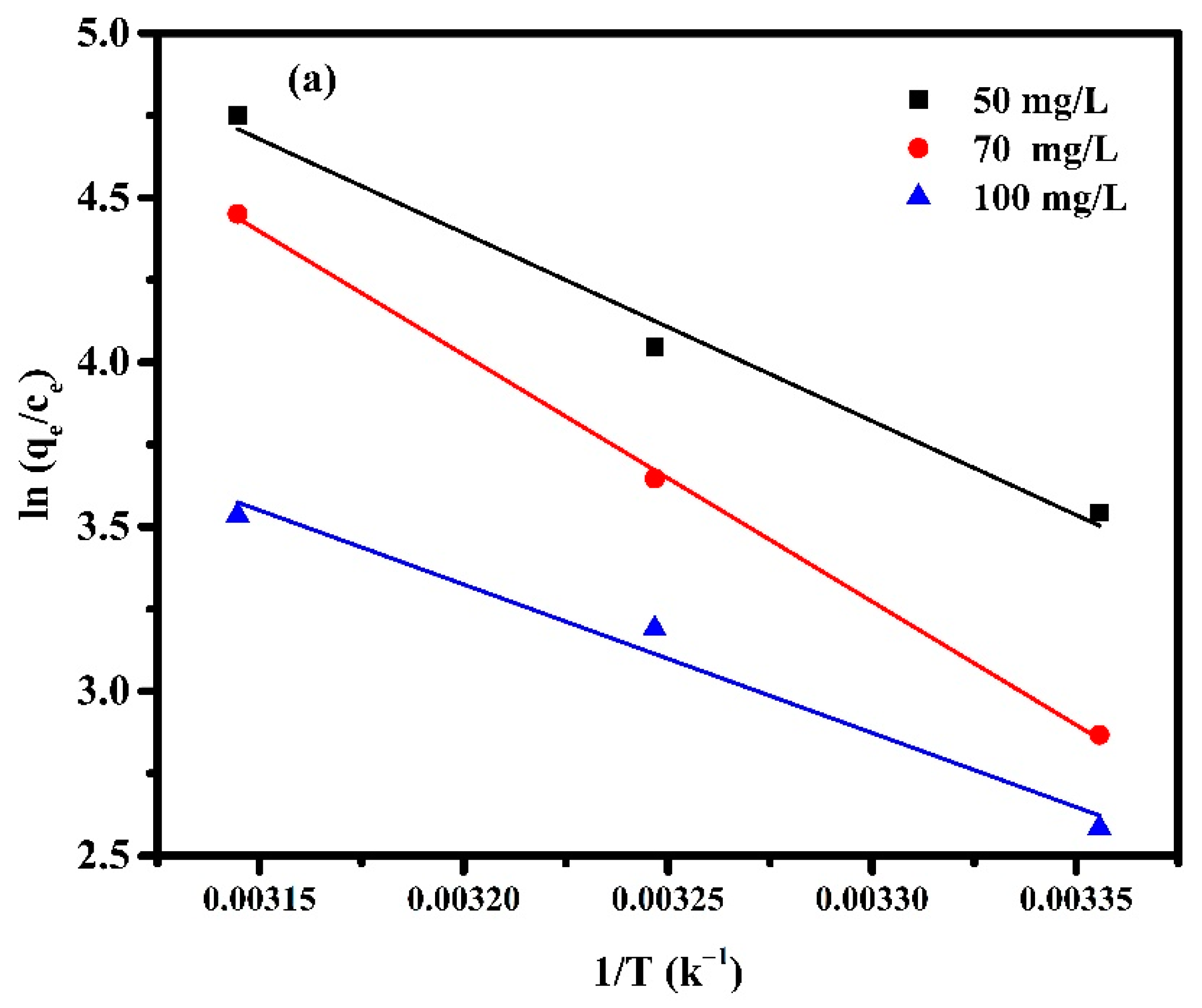

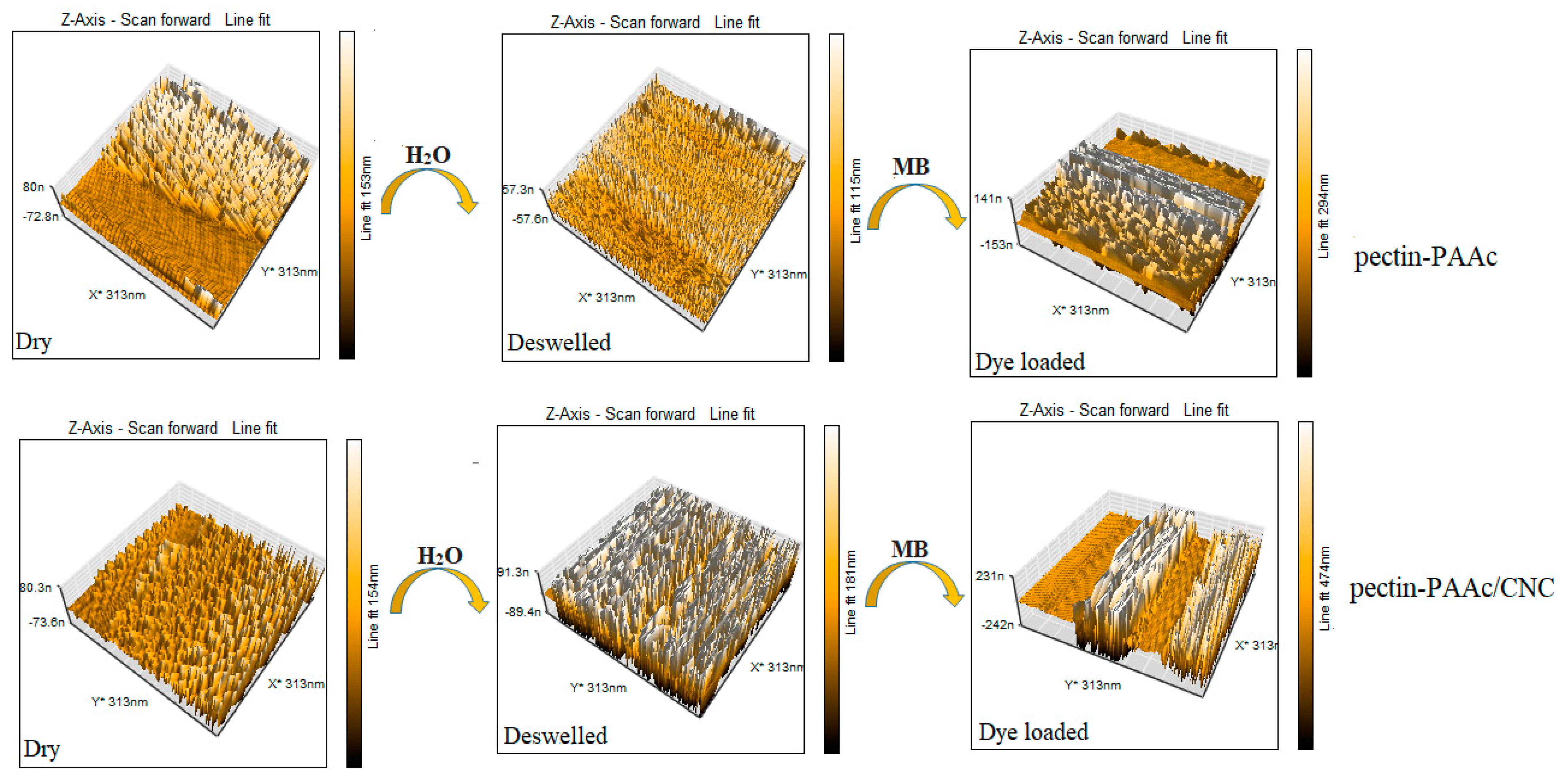
| Kinetic Model | Kinetic Constants | Pectin/PAAc | Pectin-PAAc/CNC |
|---|---|---|---|
| Pseudo-first-order PFO | K1 (min−1) | 0.02 | 0.025 |
| qe (cal.), (mg/g) | 110.12 | 139.69 | |
| qe (exp), (mg/g) | 115.23 | 142.81 | |
| R2 | 0.95051 | 0.98274 | |
| ∆q% | 5.08 | 2.50 | |
| Pseudo-second-order PSO | K2 (g mg−1 min−1) | 1.66 × 10−4 | 1.51 × 10−4 |
| qe (cal.), (mg/g) | 132.49 | 172.87 | |
| qe (exp), (mg/g) | 115.23 | 142.81 | |
| R2 | 0.93674 | 0.98568 | |
| ∆q% | 14.27 | 25.59 | |
| Avrami Avr. | kAV (min−1) | 0.15 | 0.17 |
| nAV | 0.15 | 0.17 | |
| qe (cal.), (mg/g) | 113.80 | 139.24 | |
| qe (exp), (mg/g) | 115.23 | 142.81 | |
| R2 | 0.91549 | 0.9784 | |
| ∆q% | 1.40 | 2.80 |
| Intraparticle Diffusion Parameters | Pectin-PAAc | Pectin-PAAc/CN |
|---|---|---|
| C (mg g−1) | 2.70104 | 3.99181 |
| Ki (mg g−1 min−1/2) | 8.89855 | 12.37806 |
| R2 | 0.9843 | 0.97763 |
| Adsorption Isotherm | Model Parameter | Pectin-PAAc | Pectin-PAAc/CNC |
|---|---|---|---|
| Langmuir | qm | 486.67 | 576.62 |
| KL | 0.61 | 4.87 | |
| R2 | 0.9971 | 0.9999 | |
| ∆qe (%) | 2.59 | 6.92 | |
| Freundlich | KF | 326.81 | 472.76 |
| n | 9.78 | 12.98 | |
| R2 | 0.9518 | 0.9723 | |
| ∆qe (%) | 15.24 | 19.68 | |
| Temkin | KT (L/g) | 32.50 | 215.44 |
| bT (J/mol) | 13.87 | 24.47 | |
| R2 | 0.9587 | 0.9482 | |
| ∆qe (%) | 70.96 | 35.51 | |
| Jovanovic | qmJ | 444.27 | 541.95 |
| KJ | −0.3849 | −9.6266 | |
| R2 | 0.9057 | 0.8743 | |
| ∆qe (%) | 7.57 | 21.76 | |
| Redlich–Peterson | KRP | 1329.46 | 13,597.43 |
| 0.7499 | 25.84 | ||
| β | 0.9697 | 0.9713 | |
| R2 | 0.9971 | 0.9528 | |
| ∆qe (%) | 12.40 | 18.97 | |
| Brouers–Sotolongo | qmBS | 468.73 | 572.65 |
| KBS | 0.5457 | 2.1217 | |
| 0.6 | 0.31503 | ||
| R2 | 0.9999 | 0.9531 | |
| ∆qe (%) | 2.39 | 9.23 |
| Thermodynamic Parameter | Pectin-PAAc | Pectin-PAAc/CNC | |||||
|---|---|---|---|---|---|---|---|
| 50 mg/L | 70 mg/L | 100 mg/L | 50 mg/L | 70 mg/L | 100 mg/L | ||
| ∆G (kJ mol−1) | Temp. (K) | ||||||
| 298 | −9.12 | −6.17 | −7.2 | −15.46 | −8.87 | −8.81 | |
| 308 | −11.02 | −8.47 | −8.7 | −17.66 | −11.97 | −10.21 | |
| 318 | −12.92 | −10.77 | −10.2 | −19.86 | −15.07 | −11.61 | |
| ∆S (kJ mol−1 K−1) | 0.19 | 0.23 | 0.15 | 0.22 | 0.31 | 0.14 | |
| ∆H (kJ mol−1) | 47.50 | 62.37 | 37.50 | 50.10 | 83.51 | 32.93 | |
Publisher’s Note: MDPI stays neutral with regard to jurisdictional claims in published maps and institutional affiliations. |
© 2022 by the authors. Licensee MDPI, Basel, Switzerland. This article is an open access article distributed under the terms and conditions of the Creative Commons Attribution (CC BY) license (https://creativecommons.org/licenses/by/4.0/).
Share and Cite
Al-Gorair, A.S.; Sayed, A.; Mahmoud, G.A. Engineered Superabsorbent Nanocomposite Reinforced with Cellulose Nanocrystals for Remediation of Basic Dyes: Isotherm, Kinetic, and Thermodynamic Studies. Polymers 2022, 14, 567. https://doi.org/10.3390/polym14030567
Al-Gorair AS, Sayed A, Mahmoud GA. Engineered Superabsorbent Nanocomposite Reinforced with Cellulose Nanocrystals for Remediation of Basic Dyes: Isotherm, Kinetic, and Thermodynamic Studies. Polymers. 2022; 14(3):567. https://doi.org/10.3390/polym14030567
Chicago/Turabian StyleAl-Gorair, Arej S., Asmaa Sayed, and Ghada A. Mahmoud. 2022. "Engineered Superabsorbent Nanocomposite Reinforced with Cellulose Nanocrystals for Remediation of Basic Dyes: Isotherm, Kinetic, and Thermodynamic Studies" Polymers 14, no. 3: 567. https://doi.org/10.3390/polym14030567
APA StyleAl-Gorair, A. S., Sayed, A., & Mahmoud, G. A. (2022). Engineered Superabsorbent Nanocomposite Reinforced with Cellulose Nanocrystals for Remediation of Basic Dyes: Isotherm, Kinetic, and Thermodynamic Studies. Polymers, 14(3), 567. https://doi.org/10.3390/polym14030567






